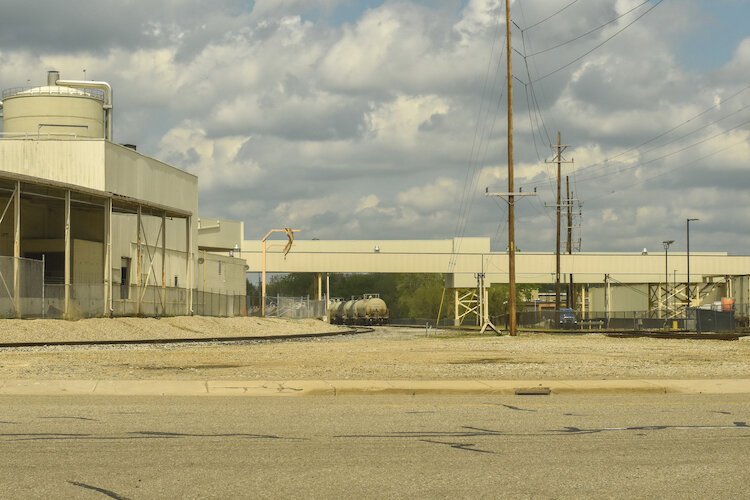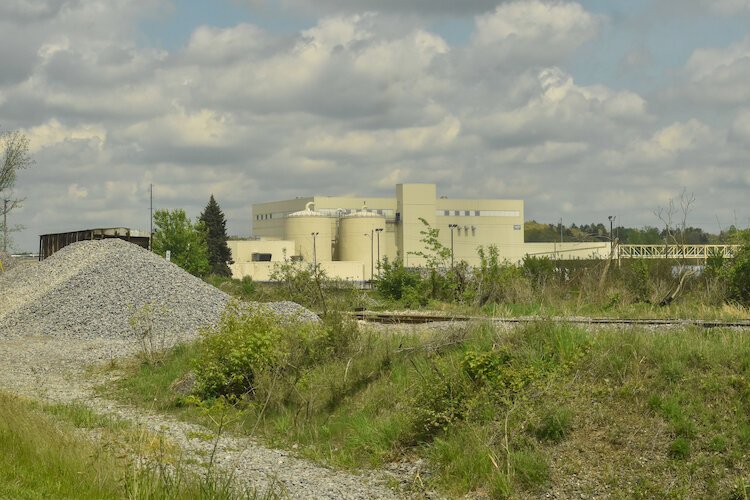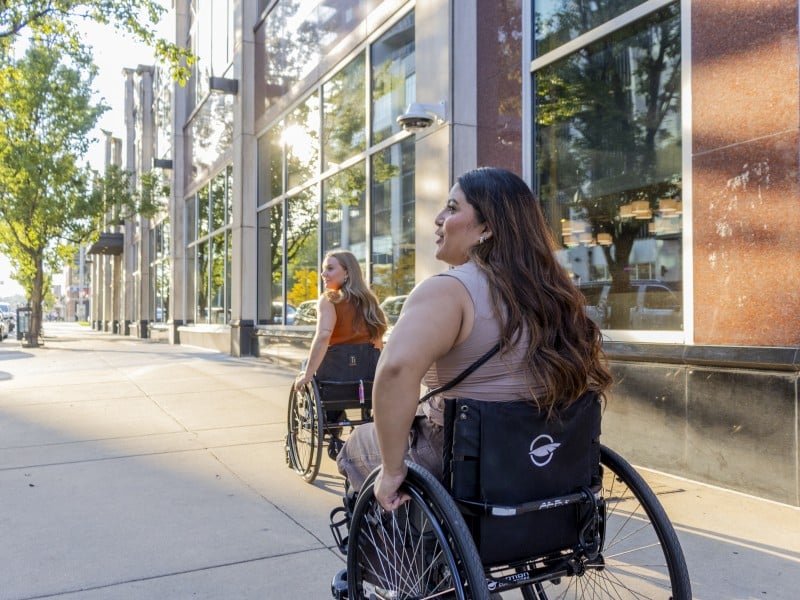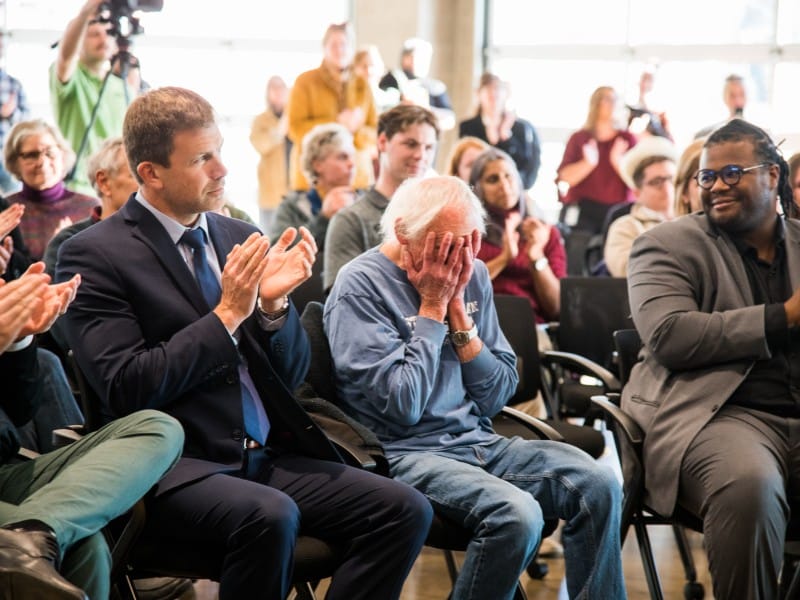Voices of Youth: Meet the man helping to make Kalamazoo a more sustainable city
The City of Kalamazoo aims to be 'net zero' by 2050. Kalamazoo's Sustainability Planner Justin Gish plans to help the city get there. VOY's Dmitri Agdanowski sits down with Gish to find out more.
Editor’s Note: This story was reported and photographed by Dimitri Agdanowski as part of the Spring 2024 Kalamazoo Voices of Youth Program. The program is a collaboration between Southwest Michigan Second Wave and KYD Network in partnership with the YMCA of Greater Kalamazoo, funded by the Stryker Johnston Foundation. The Voices of Youth Program is led by Earlene McMichael. VOY Mentors were Maya James (writing) and Casey Grooten (art).
KALAMAZOO, MI — When walking, biking, or driving around Kalamazoo, it is hard not to see it is becoming a more sustainable place to live, but did you know there’s someone whose job is to watch over that effort?
Kalamazoo Voices of Youth writer Dimitri Agdanowski stumbled upon the unique role of the city of Kalamazoo sustainability planner while researching a story about how pollutants are affecting Kalamazoo, then quickly shifted gears to covering instead how this job impacts the city.
Sustainability Planner Justin Gish is in charge of making sure the city meets its goal of being “net zero” by 2050. The “net zero” target is to lower levels of greenhouse gasses, like carbon dioxide, to the point of no emissions. Gish is doing a lot to make Kalamazoo more sustainable for the local community, as well as for the natural environment. Agdanowski interviewed him to learn more.
Kalamazoo’s carbon emission landscape
VOY: What does your job look like as a Sustainability Planner for Kalamazoo?
Gish: My job is to oversee the community sustainability plan. So, ultimately, the goal is to get the city to net zero by 2050. I track greenhouse gasses that are released through city operations and try to find ways to mitigate them year after year. So, we recently released the first baseline report that’s out there. I can send you a link to that.

But the city has 50,053 metric tons of CO2 (carbon dioxide) released in 2022. I’m starting to collect the numbers for 2023 now to see if we’re trending up — number one goal. And then, beyond that, I work on invasive species and native species, trying to figure out what to do with urban deer, support other departments like recycling and composting, and things like that — pretty much anything to do with the environment that isn’t someone else’s job already, is mine.
VOY: What successes have you had in this, like what have been your major breakthroughs with this overall, so far?
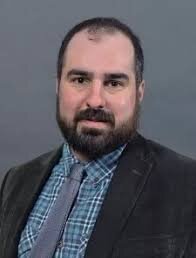
Gish: We have the goal of net zero. … You got to kind of figure out where you’re at, you know, with other departments to bring that greenhouse gas report together. That’s been the biggest success so far. And then based on that, we can figure out where we need to go from here to get to net zero.
VOY: In the city’s 2025 plan, the city wants to increase recycling. Have you guys had any major breakthroughs on that? Is that your rule? What is happening?
Gish: I support the guy whose job it is, Chris Broadbent, the solid waste coordinator. I know recycling numbers have been trending up. … I’ve seen his numbers. We talk a bit and numbers are trending up. So, the recycling for sure. … I think those numbers are going up as well.
Growing deer population
VOY: You mentioned urban wildlife like deer. What’s the main concern with that right now?
Gish: Yes, a lot of residents have expressed concerns about deer. Too many deer impacting the natural environment. They’re eating young, young, tree saplings before they can grow, so there’s no understory at the natural areas in the city. Some deer are getting into people’s yards and eating their decorative plants, things like that (and some are) concerned for public health.
So, folks are just reaching out asking, what can we do about it? And, as of yet, (we are) still trying to figure that out, you know. Other cities have done a cull where they kind of manage deer through targeted hunting. But that’s not where we’re at. Now, a couple of years ago, the city released a deer management plan that … kind of lays out the next steps. We’re in the very early phases of that plan, just education outreach. Just trying to gather as much data as we can right now.
VOY: What is the city doing for more sustainable transportation, too? I know that that was mentioned in the 2025 plan.
Gish: Yeah, definitely the bike lanes downtown. And I have some numbers that show that, like, rider usage has gone up over the years. You know, correlation causation. You can assume that it’s the bike lanes. Could be something else, but I’ll send you those numbers. … The bike lanes are a big piece of public outreach. I know the community planner here. No one has been working on the bike event. So, we put on the bike show a couple of weeks ago, and they were held, that kind of “if you build it, they will ride” scenario.
VOY: What do you think Kalamazoo is struggling with right now in sustainability?
Gish: That’s a good one. You know, I’d like to see more renewable energy in the city in city buildings. I wouldn’t say it’s necessarily a struggle. It’s just an issue that I’m working on. So, going back to the baseline report, 83%, of all of our emissions in the community, which is 2.1 million metric tons of CO2, that’s all attributed to energy use. So, burning of natural gas in homes, businesses, industry, and electrical use in homes, businesses, and industry — looking at that piece of that pie. I mean, 83%. Renewable energy would come in; it would help with that. Bring those numbers down.
Efforts homeowners can make
VOY: What would it look like to get more renewables into Kalamazoo? Is this something that would take long or would it be a shorter push?
Gish: Yeah, so immediate things: businesses, homes (that) have the means and the will, they could put solar panels on their homes, businesses, factories, whatever, that would meet that immediate need there.
By 2040, the state’s public utilities are required to go greener. And, you know, you have to look at the exact terms. So, by 2040, things will change. But immediately, folks can put solar panels on their homes. They can focus on efficiency and behavior change, too. You know, so maybe you’re not paying attention to how much energy you use. I encourage folks to use the EPA carbon calculator online to tell us what your carbon footprint is based on your energy use. So, (if) you input your utility bill data, they’ll let you know as an individual or household, how much CO2 you’re losing in the atmosphere. And then based on integration, you can change your opinion if you want, your behaviors.
VOY: Is the city doing anything to incentivize other than just putting out the data? Are they doing anything to incentivize people to put solar panels up or more sustainable activity?
Gish: That’s not the city’s role necessarily. The state has some programs and the federal government has programs. The tax rebate is a credit like that. Here, at the city level, we’re working on making sure the permitting process is important. That’s where the city comes in. So, if you want to put solar panels on your house, there are no barriers from the city, as far as permitting goes or installation or anything like that. We don’t have any incentive programs, but we’re always looking for grants to try to get those projects off the ground.
Food sustainability
VOY: Another part of the 2025 plan is food sustainability. I don’t know if you can talk about that. But what would it take for Kalamazoo to be more sustainable in the way it sources its food?
Gish: Local generally is the key there. Rachel Bair (is the director of sustainable food programs at) Kalamazoo Valley Community College and (works with its ValleyHub). So that’s kind of a neat system where (an) institution like Bronson (Methodist Hospital) wants to buy locally sourced vegetables from a farmer but the amount of tomatoes that they need is just (too much), you know. …
The food hub brings local farmers together to kind of pool their tomatoes that they can then sell to Bronson, so it’s a pretty neat system. It’s all local farmers there. The city has supported it in the past, but I think the Kalamazoo Valley food hub is the most impressive kind of local food player in the game.
VOY: With community gardens, is there any outreach from the city to build more or is it all just like citizens building them?
Gish: Yeah, we have a community garden in Henderson Park, near Henderson Castle. It’s on city property, but it’s managed by residents in the neighborhood.
Dimitri Agdanowski is a rising senior at Loy Norrix High School in Kalamazoo, Michigan this fall.




